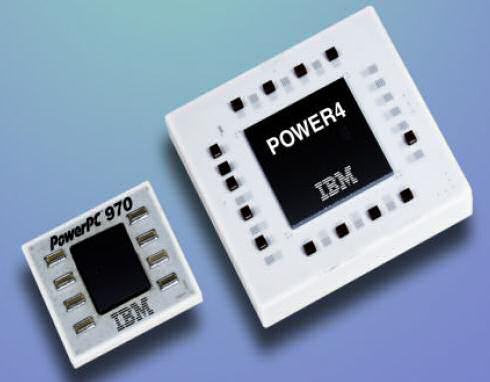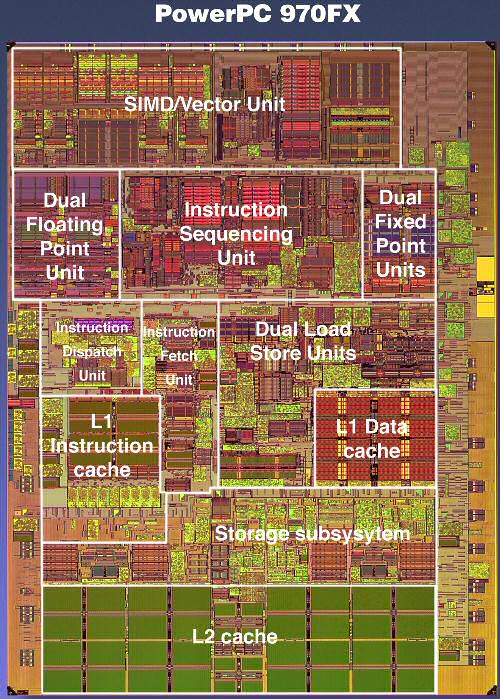No more mysteries: Apple's G5 versus x86, Mac OS X versus Linux
by Johan De Gelas on June 3, 2005 7:48 AM EST- Posted in
- Mac
IBM PowerPC 970FX: Superscalar monster
Meet the G5 processor, which is in fact IBM's PowerPC 970FX processor. The RISC ISA, which is quite complex and can hardly be called "Reduced" (The R of RISC), provides 32 architectural registers. Architectural registers are the registers that are visible to the programmer, mostly the compiler programmer. These are the registers that can be used to program the calculations in the binary (and assembler) code.
The 970FX is deeply pipelined, quite a bit deeper than the Athlon 64 or Opteron. While the Opteron has a 12 stage pipeline for integer calculations, the 970FX goes deeper and ends up with 16 stages. Floating point is handled through 21 stages, and the Opteron only needs 17. 21 stages might make you think that the 970FX is close to a Pentium 4 Northwood, but you should remember that the Pentium 4 also had 8 stages in front of the trace cache. The 20 stages were counted from the trace cache. So, the Pentium 4 has to do less work in those 20 stages than what the 970FX performs in those 16 or 21 stages. When it comes to branch prediction penalties, the 970FX penalty will be closer to the Pentium 4 (Northwood). But when it comes to frequency headroom, the 970FX should do - in theory - better than the Opteron, but does not come close to the "old" Pentium 4.

The 970FX works out of order and up to 200 instructions can be kept in flight, compared to 126 in the Pentium 4. The rate at which instructions are fetched will not limit the issue rate either. The PowerPC 970 FX fetches up to 8 instructions per cycle from the L1 and can decode at the same rate of 8 instructions per cycle. So, is the 970FX the ultimate out-of-order CPU?
While 200 instructions in flight are impressive, there is a catch. If there was no limitation except die size, CPUs would probably keep thousands of instructions in flight. However, the scheduler has to be able to pick out independent instructions (instructions that do not rely on the outcome of a previous one) out of those buffers. And searching and analysing the buffers takes time, and time is very limited at clock speeds of 2.5 GHz and more. Although it is true that the bigger the buffers, the better, the number of instructions that can be tracked and analysed per clock cycle is very limited. The buffer in front of the execution units is about 100 instructions big, still respectable compared to the Athlon 64's reorder buffer of 72 instructions, divided into 24 groups of 3 instructions.
The same grouping also happens on the 970FX or G5. But the grouping is a little coarser here, with 5 instructions in one group. This grouping makes reordering and tracking a little easier than when the scheduler would have to deal with 100 separate instructions.
The grouping is, at the same time, one of the biggest disadvantages. Yes, the Itanium also works with groups, but there the compilers should help the CPU with getting the slots filled. In the 970FX, the group must be assembled with pretty strict limitations, such as at one branch per group. Many other restrictions apply, but that is outside the scope of this article. Suffice it to say that it happens quite a lot that a few of the operations in the group consist of NOOP, no-operation, or useless "do nothing" instructions. Or that a group cannot be issued because some of the resources that one member of the group needs is not available ( registers, execution slots). You could say that the whole grouping thing makes the Superscalar monster less flexible.
Branch prediction is done by two different methods each with a gigantic 16K entry history table. A third "selector" keeps another 16K history to see which of the two methods has done the best job so far. Branch prediction seems to be a prime concern for the IBM designers.
Memory Subsystem
The caches are relatively small compared to the x86 competition. A 64 KB I-cache and 32 KB D-cache is relatively "normal", while the 512 KB L2-cache is a little small by today's standards. But, no complaints here. A real complaint can be lodged against the latency to the memory. Apple's own webpage talks about 135 ns access time to the RAM. Now, compare this to the 60 ns access time that the Opteron needs to access the RAM, and about 100-115 ns in the case of the Pentium 4 (with 875 chipset).A quick test with LM bench 2.04 confirms this:
| Host | OS | Mem read (MB/s) | Mem write (MB/s) | L2-cache latency (ns) | RAM Random Access (ns) |
| Xeon 3.06 GHz | Linux 2.4 | 1937 | 990 | 59.940 | 152.7 |
| G5 2.7 GHz | Darwin 8.1 | 2799 | 1575 | 49.190 | 303.4 |
| Xeon 3.6 GHz | Linux 2.6 | 3881 | 1669 | 78.380 | 153.4 |
| Opteron 850 | Linux 2.6 | 1920 | 1468 | 50.530 | 133.2 |
Memory latency is definitely a problem on the G5.
On the flipside of the coin is the excellent FSB bandwidth. The G5/Power PC 970FX 2.7 GHz has a 1.35 GHz FSB (Full Duplex), capable of sending 10.8 GB/s in each direction. Of course, the (half duplex) dual channel DDR400 bus can only use 6.4 GB/s at most. Still, all this bandwidth can be put to good use with up to 8 data prefetch streams.










116 Comments
View All Comments
exdeath - Friday, June 3, 2005 - link
Wow look at a 2.4 GHz Opteron clean house.I'd like to see what a 2.6 GHz FX-55 with unregistered memory would do ;) I'll be fair and say keep it at 2.6 GHz stock ;)
bersl2 - Friday, June 3, 2005 - link
Right. GCC 4.0 has an all new optimization framework, including autovectorization:http://gcc.gnu.org/projects/tree-ssa/vectorization...
Pannenkoek - Friday, June 3, 2005 - link
It is well known that GCC 3.3 can't vectorize code. However, GCC 4 should be able to, eventually if not already.The small cache of the G5 would hamper its server performance I'd reckon, regardless of other factors.
jimbailey - Friday, June 3, 2005 - link
I'm curious if you rebuilt Apache and MySQL from source. Apple has added significant amount of optimization to gcc and I would love to know if it has been included in this test. I don't doubt the results though. The trade off for using the Mach micro-kernel is well known.rubikcube - Friday, June 3, 2005 - link
Johan, I agree that all the facts point to your conclusions being accurate. I would bet all the money in the world that you are correct. However, this hypothesis is easily confirmed by running mysql on a G5 running linux.Olaf van der Spek - Friday, June 3, 2005 - link
> In Unix, this is done with a Syscall, and it results in two context switches (the CPU has to swap out one process for another)Does it?
As far as I know it doesn't. The page tables don't need to be swapped and neither does the CPU state. The CPU gets access to the kernel-data because it goes to kernel-mode, but that doesn't require a full context switch I think.
WileCoyote - Friday, June 3, 2005 - link
Tough crowd...Eug - Friday, June 3, 2005 - link
Of the stuff I understand, I agree with your conclusions, but I think it's reasonable to state that running Linux on the G5 yourself would have been the most definitive test.Anyways, I like fusion food. :)
cHodAXUK - Friday, June 3, 2005 - link
Great article, very educational read and it was very interesting to see what is holding the G5 back. IBM/Apple really need to address these issues, people are paying alot of money for G5's that are dilvering nowhere near the level of performance that they *theoretically* should be.Netopia - Friday, June 3, 2005 - link
WOW... great article.I too would like to see Yellow Dog (Or FC4) loaded on the G5 for a true head-to-head. I hope you have the time with the box to get 'er done!
Joe